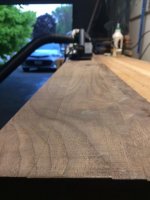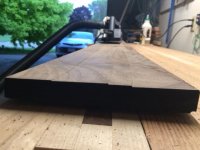Hi, i just got an 850 planer and I'm looking for some tips on how to use it right. See attached images, I started from the right side of the board with 0.1mm setting. After 1-3 passes it removes a lot of material. Then, when i move to the left and do 3 passes it doesn't bring it to the same level, I get the stairs effect as I move to my left although i take the same # of pssses and the planer is lovked in the .1mm setting.
How do you guys plane a 10" board to avoid this issue? Other yhen my lack of skills, the tool is excellent, it removes wood so fadt compared to my hand planers.
Thanks
george
How do you guys plane a 10" board to avoid this issue? Other yhen my lack of skills, the tool is excellent, it removes wood so fadt compared to my hand planers.
Thanks
george


